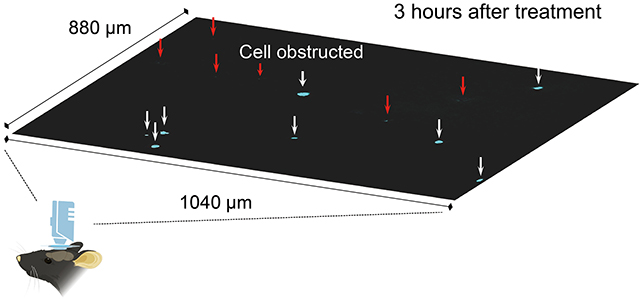ARTICLE AD
With microplastics now permeating our food and our bodies, researchers are keen to assess the potential damage these tiny fragments could be doing. A new study shows how plastics may lead to dangerous blood flow blockages in the brain.
The study, led by a team from the Chinese Research Academy of Environmental Sciences in Beijing, involved tracking microplastics in blood vessels moving through mouse brains in real time – the first time microplastic movement has been tracked in this way.
Using high-resolution laser-based imaging techniques, the researchers found microplastic-laden immune cells becoming lodged inside blood vessels in the cortex area of the brain.
 Obstructions in blood vessels were found and linked to cognitive issues. (Huang et al., Science Advances, 2025)
Obstructions in blood vessels were found and linked to cognitive issues. (Huang et al., Science Advances, 2025)"Our data reveal a mechanism by which microplastics disrupt tissue function indirectly through regulation of cell obstruction and interference with local blood circulation, rather than direct tissue penetration," write the researchers in their published paper.
"This revelation offers a lens through which to comprehend the toxicological implications of microplastics that invade the bloodstream."
The researchers found some similarities between the blockages here and blood clots, while also looking at the subsequent impact on mouse behavior. Mice with microplastics in their blood performed less well than their plastic-free peers on movement, memory, and coordination tests, pointing to impaired brain function.
Microplastics are defined as plastic fragments less than 5 millimeters (0.2 inches) in diameter. As you might expect, the smaller specks of plastic were found to be less likely to cause blockages than larger ones.
While the microplastic blockages were cleared up over the course of a month, and most cognitive behaviors in the mice returned to normal, the researchers suggest there could be links here to neurological problems like depression and anxiety, as well as an increased risk of strokes and cardiovascular disease.
"These findings indicate that mice display multifaceted abnormalities in neurobehavioral regulation, resembling depressive states associated with disrupted cerebral blood flow," write the researchers.
While it's not certain that the same processes are happening in human brains – there are significant differences in terms of immune systems and blood vessel sizes – mice are biologically similar enough to us as a species to make this a real concern.
There's a lot more to explore in terms of the mechanisms behind these blockages, the long-term effects, and which animals could be affected. The researchers also point to other studies that have begun to analyze potential links between microplastics and disease risk, though no direct relationship in humans has yet been found.
"The use of larger mammals or animal models that more closely resemble the human circulatory system, such as non-human primates, is thus crucial for studying this process," write the researchers.
"The potential long-term effects of microplastics on neurological disorders such as depression and cardiovascular health are concerning."
The research has been published in Science Advances.

 2 hours ago
1
2 hours ago
1 

